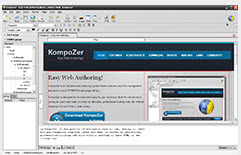
- #Install kompozer how to#
- #Install kompozer install#
- #Install kompozer update#
- #Install kompozer code#
Test.php slugify ( 'Hello World, this is a long sentence and I need to make a slug from it!' )
#Install kompozer code#
Create the file test.php and open it in your text editor:Īdd the following code which brings in the vendor/autoload.php file, loads the cocur/slugify dependency, and uses it to create a slug: This file is automatically generated by Composer when you add your first dependency.

The only thing you need to do is include the vendor/autoload.php file in your PHP scripts before any class instantiation. This makes it much easier to work with your dependencies. Since PHP itself doesn’t automatically load classes, Composer provides an autoload script that you can include in your project to get autoloading for free.
#Install kompozer how to#
Next, let’s look at how to load dependencies automatically with Composer. >= 1.0 = 1.1.0 = 1.0 = 1.0.0 = 1.0 = 1.2 < 1.3įor a more in-depth view of Composer version constraints, see the official documentation. Here are some examples to give you a better understanding of how Composer version constraints work: However, some situations might require that you manually edit the constraints–for instance, when a major new version of your required library is released and you want to upgrade, or when the library you want to use doesn’t follow semantic versioning. Generally speaking, you won’t need to tamper with version constraints in your composer.json file. In this case, it defines 4.0 as the minimum compatible version, and allows updates to any future version below 5.0. The caret ( ^) operator used by the auto-generated composer.json file is the recommended operator for maximum interoperability, following semantic versioning. Composer supports several different constraints and formats for defining the required package version, in order to provide flexibility while also keeping your project stable. You might notice the special character ^ before the version number in composer.json. Now execute the following PHP script to verify that the installation script is safe to run: Make sure that you substitute the latest hash for the highlighted value.


Copy the hash from that page and store it as a shell variable: Next, verify that the installer matches the SHA-384 hash for the latest installer found on the Composer Public Keys / Signatures page. Make sure you’re in your home directory, then retrieve the installer using curl:
#Install kompozer install#
We’ll download it, verify that it’s not corrupted, and then use it to install Composer. Step 2 - Downloading and Installing ComposerĬomposer provides an installer, written in PHP. With the prerequisites installed, we can install Composer itself. sudo apt install curl php-cli php-mbstring php-curl git unzip.Everything can be installed with the following command:

git is used by Composer for downloading project dependencies, and unzip for extracting zipped packages. The php-mbstring package is necessary to provide functions for a library we’ll be using. We’ll need curl in order to download Composer and php-cli for installing and running it.
#Install kompozer update#


 0 kommentar(er)
0 kommentar(er)
